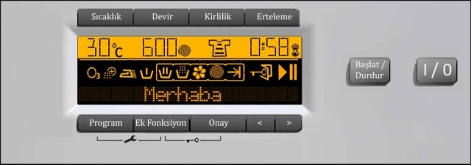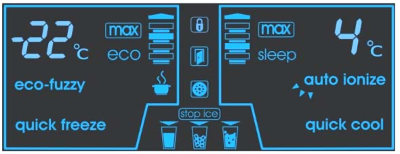Interface Evaluation
Last Updated:
Interface Design for Washing Machines
Arçelik “Energy Free” washing machine interface was evaluated with expert analysis and usability problems were classified in terms of consistency , feedback and conformity to the users’ mental model regarding energy saving. Design recommendations were presented in the form of computer based animations. 
Interface Design for Dishwashers
The alphanumeric screen-based dishwasher interface model was evaluated with expert analysis to provide solutions to usability problems. Design recommendations were presented in the form of computer based animations.

Expert Analysis and Interface Design for Clothes Dryers
The clothes dryer interface was evaluated with an expert analysis and complementary methods to specify the usability problems. The interface was examined both in terms of the screen design and physical qualities. The study consisted of a comparative study of the product with two competing models. Another evaluation criterion was the interface’s consistency among the brand’s other products; therefore two other product interfaces from the same product family, a lower-end dryer without a screen display and a washing machine, were also examined.

Expert analysis and Interface Design for an Oven Interface
In the study, a detailed expert analysis of the Arçelik oven interface, together with nine competing models with diverse interface characteristics were made. Design recommendations were developed regarding the firm’s future design objectives. The detected usability problems, together with the general interface trends and conventions were examined to define design guidelines for interface structure and icon design.

Usability Testing and Interface Design for Washing Machines
The project aimed to develop design guidelines and novel interface concepts for the screen-based washing machine interfaces, based on the usability evaluation of the available interfaces. The study started with a benchmarking and usability study that compares the product and competing models’ interfaces through user participation. The products were evaluated in terms of usability and usefulness, as well as visual qualities and the perceived quality in the first impression. In addition to this core study, general information regarding usage and product functions was gathered with questionnaires and interviews. This information was further supported with a large-sample questionnaire on user preferences and requirements related to product use. The resulting design recommendations included a patented interface concept.
Expert Analysis of a Dishwasher Interface
The project aimed to solve usability problems of a dishwasher interface which had been in production and received user complaints. In the initial phase, user complaints were evaluated. Then the interface algorithm and the consistency among the product family were examined to come up with low-cost improvements on the interface.
Expert Analysis and Interface Design of a Refrigerator Interface
A digital refrigerator interface prototype was analyzed through examining the function table and interface algorithm. Problems regarding the physical and cognitive structure were defined and itemized according to severity. Design recommendations including icon and display behavior were developed and presented with snapshots and computer animations.

Usability Testing, Consumer Expectations Analysis and Benchmarking for Dishwashers
An alphanumeric screen-based dishwasher model, Arçelik Ecologist, was evaluated based on usability criteria and user requirements, by a comparative study which included two of the competing brands’ models. The study consisted of usability tests, motion analysis to explore perceived quality based on the first impression, user requirements questionnaires and focus group studies to develop long-lasting design guidelines.

